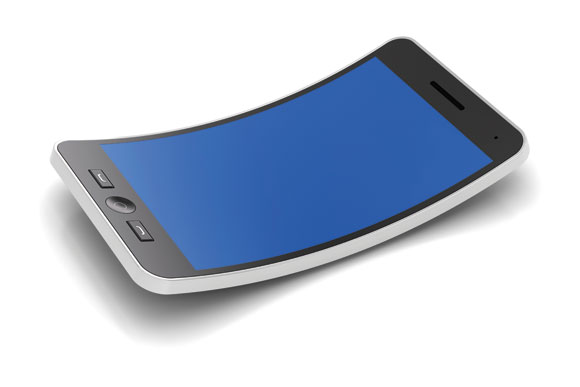



Feature Story
More feature stories by year:
2024
2023
2022
2021
2020
2019
2018
2017
2016
2015
2014
2013
2012
2011
2010
2009
2008
2007
2006
2005
2004
2003
2002
2001
2000
1999
1998
 Return to: 2015 Feature Stories
Return to: 2015 Feature Stories
CLIENT: CAMBRIOS
Aug. 10, 2015: Embedded Systems Engineering
By Sri Peruvemba, Cambrios Technologies Corp.
Here's what's set to shrink the role glass touch screen displays will have—in digital signage, in automobiles, in games, or in anyplace where screens are bending the old rules.
Industry analysts across the globe expect the market for transparent conductor film used in touch screens to grow at a rapid pace, replacing their glass counterparts as well as enabling new applications. According to industry research firm IDTechEx, worldwide shipments of touch screen panels are set to take twice as much surface area in 10 years as they did in 2014 (Figure 2).
 Figure 1: Likely products that will take advantage of new touch screen technology include but aren't limited to, curved, shaped smartphones and flexible tablets as well as wearable smart bracelets and watches. Such products are specifically enabled by flexible device technology.
Figure 1: Likely products that will take advantage of new touch screen technology include but aren't limited to, curved, shaped smartphones and flexible tablets as well as wearable smart bracelets and watches. Such products are specifically enabled by flexible device technology.
Helping drive this anticipated growth are greater touch sensitivity, enhanced luminance, bendable touch screens, wraparound screens and dramatically lower overall cost. The ability to perform environmentally sustainable manufacturing of silver nanowire-based touch screens is also a growth factor, which along with those just named is pushing indium tin oxide (ITO) to the side. Like dial up modems, manual transmissions and wired LANs, ITO's limitations don't work for 'what's next.'
While there seems to be a constant stream of technical breakthroughs in computing systems, particularly in processors, memory and faster interfaces, revolutionary changes are also occurring in display and touch technology.
New materials are triggering a wave of innovation in personal electronics. Driving these changes are incredibly small, highly integrated and far easier to program microcontrollers and flexible circuit boards combined with silver nanowire-based touch screen technology.
And now touch screen displays no longer have to be flat. Flat and rigid are out. Curved and flexible are in. Additionally, most touch screens require high-quality transparent conductors to provide a rich user experience. These features are being applied to products that will make today's tablet computers appear as dated as desktops and help push portable computing into entirely new sectors and price points. Kiosks, gaming machines, point-of-sale devices, automobile displays and medical devices are a few key categories ripe for adoption.
Flexible dispeecat-081015-1lays definitely equate to improved ergonomics. Imagine unbreakable phone screens that flex instead of shattering when dropped. Consider folding a tablet so it slips into your pocket like a mobile phone. How about a display that wraps around your wrist, or a huge public display wrapping around a pillar or the corner of a building like a huge cloth banner does? We are driving toward products like these. And they are creating increasing demand for flexible, bendable and rollable displays using silver nanowires.
 Figure 2: Touch screen growth by surface area. Data courtesy Dr. Khasha Ghaffarzadeh, IDTechEx Research.
Figure 2: Touch screen growth by surface area. Data courtesy Dr. Khasha Ghaffarzadeh, IDTechEx Research.
Some digital signage applications require touch functionality. For example, interactive kiosks use touch functionality to allow users to navigate the menu while providing input. Traditional touch technologies did not have the electrical conductivity to provide a good experience. And forget about 10-finger touch or a sleek design that isn't hampered by heavy sheets of glass or other bulky technologies. Silver nanowire-based touch screens leave all these problems behind.
Hand-held and desk top gaming demands excellent touch functionality paired with thin, light, and aesthetically pleasing designs. Examples of leading-edge touch-enabled products can be found in the range of tablets from consumer electronics firm Fuhu, Inc.These demonstrate what's now possible with touch-enabled products. The casino gaming industry is also rapidly adopting new touch technology to differentiate their products and make them more attractive.
Silver nanowires are highly conductive single crystal silver nanowires suspended in a fluid/ink. These silver nanowires have diameters of a few tens of nanometers and lengths of a few tens of micrometers, giving them a high (1000:1) aspect ratio. The ink is a mixture of highly conductive silver nanowires and other materials to enable the ink to be coated on all kinds of surfaces particularly plastic film. Using this ink to cover a screen creates a touch surface that is the most responsive, drawing on silver's excellent conductivity.
Silver nanowire ink is also particularly transparent, has very good clarity and very little haze, making it ideal for displays requiring sharp, crisp images. Also, screen resistance can be customized to suit the specifications of individual OEMs and designers, which allows for variable response times. Touch screens can be used for devices, such as phones and tablets or big touch screen TVs or even exterior electronic signage. Perhaps most interestingly they can also be used in applications requiring round surfaces or conformity to angles, giving them a clear edge over conventional material that cannot bend.
As reported in "MIT Technology Review" and elsewhere, silver nanowire inks are being used in all-in-one computers and monitors made by LG, Lenovo, Dell, HP and others. The material is also found in mobile phones and tablets made by NEC in Japan, Karbonn in India and Huawei in China. Silver nanowires are also being adopted as the transparent-conductor-of-choice by leading industry heavyweights including Hitachi, LG, TPK, Nissha, 3M, Okura, CNI and others.
For emerging touch screen applications, including large-area signage and monitors, as well as miniature, flexible, wearable displays, silver nanowires offer significant advantages both in cost and performance. The material is already being used in several consumer electronics products. Roll-to-roll processed silver nanowire transparent conductors are the clear choice for new factories needing high throughput, fewer consumables and easy processing. They're also on target for CE OEMs needing a thin, light, bright, flexible material delivering high performance for their next killer application.
 Sri Peruvemba is vice president at Cambrios Technologies Corp.
Sri Peruvemba is vice president at Cambrios Technologies Corp.
Return to: 2015 Feature Stories